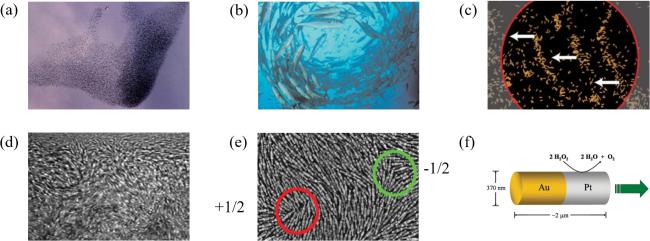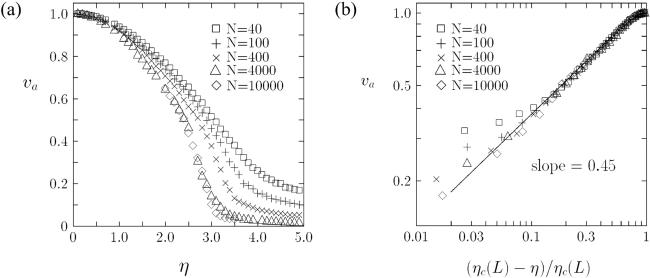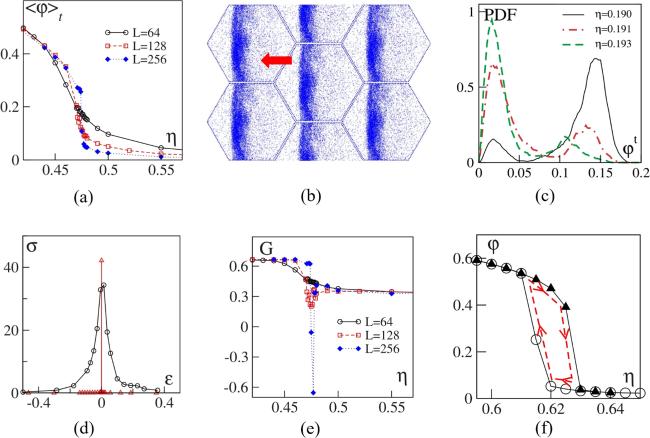1. Introduction
Figure 1. (a) A flock of birds responding to predators by flying in parallel. (b) A school of fish spontaneously forming a vortex-like columnar structure. (c) Polar order in actin filaments driven by molecular motors. (d) Active turbulence in Bacillus subtilis. (e) A monolayer of vibrating rods forming the nematic order with topological defects, where the red circle indicates a mobile + 1/2 defect and the green circle indicates an immobile −1/2 defect. (f) Random walk of gold-platinum rods driven by hydrogen peroxide. Images adopted from [1, 5, 8, 10, 11]. |
Figure 2. The cartoons of aligning active particles. Aligning active particles are generally self-propelled along their long axis, where black arrows indicate the velocity direction and right curved arrows indicate the clockwise chirality. Polar particles have head–tail asymmetry and orientational forces (polar alignment). Active nematics have head–tail symmetry and nematic forces, while self-propelled rods lack this symmetry but still experience nematic forces. Chiral aligning active particles have an intrinsic asymmetry that enables them to move in a curved or helical trajectory and exhibit left-handed or right-handed chirality. |
2. Methods
2.1. Simulation models and order parameters
2.2. Hydrodynamic theories
3. Continuous phase transitions
3.1. Continuity of the order parameter
Figure 3. Features of continuous phase transitions close to the phase transition point in the Vicsek model at low velocities, including: (a) Continuous behavior of the order parameter ${v}_{a}=\left\langle \varphi \right\rangle $; (b) scaling of the order parameter. Images adopted from [45]. |
3.2. Critical exponents and scaling relation
4. Discontinuous phase transitions
4.1. Discontinuity of the order parameter
Figure 4. Characteristics of discontinuous phase transitions near the phase transition point in the VM and VLM at high velocities. (a) The order parameter is discontinuous $\left(\rho =2,{v}_{0}=0.5\right)$; (b) High-density band structures coexist with low-density disordered gas for a hexagonal simulation cell, visualized by points representing particle positions, and the red arrow indicates band-structure movement direction $\left(\rho =2/\sqrt{3},{v}_{0}=10,L=128/\sqrt{3}\right)$; (c) The reduced average velocity exhibits a bimodal distribution, indicative of spontaneous transitions between band and disordered phases $\left(\rho =0.125,{v}_{0}=0.5,L=512\right)$; (d) The variance $\sigma ={L}^{2}\left(\left\langle {\varphi }^{2}\right\rangle -{\left\langle \varphi \right\rangle }^{2}\right)$ exhibits an abrupt peak $\left(\varepsilon =\left({\eta }_{{\rm{c}}}-\eta \right)/{\eta }_{{\rm{c}}},\rho =2,{v}_{0}=0.5,L=64\right)$; (e) The Binder cumulant G exhibits minima below 0 $\left(\rho =2,{v}_{0}=0.5\right)$; (f) A hysteresis phenomenon is observed, characterized by parameter changes over time, illustrated by red arrows $\left(\rho =0.5,{v}_{0}=0.5,L=32\right)$. The symbol $\eta $ used in the pictures is $2\pi $ times the previously defined symbol $\eta $. The density $\rho =N/{L}^{d}$. Figures 4(a)–(e) illustrate the VM, while figure 4(f) shows the VLM in three dimensions with a vectorial noise. Images adopted from [84, 85, 113]. |
4.2. Phase coexistence
Figure 5. Steady-state snapshots. (a) Nematic phase with a noise of 0.08. (b), (c) Nematic band phase with the coexistence of the low-density disordered region and the high-density band with a noise of 0.1 and 0.13, respectively. (d) Chaotic thin band phase with a noise of 0.168. (e) Disordered phase with a noise of 0.2. Images adopted from [88]. |
Figure 6. (a) Phase diagram in the $\left({D}_{0},{\rho }_{0}\right)$ plane, where ${D}_{0}=\left({D}_{\parallel }-{D}_{\perp }\right)/\left({D}_{\parallel }+{D}_{\perp }\right)$, ${D}_{\parallel }$ and ${D}_{\perp }$ are the longitudinal and transversal diffusion constants, respectively, and ${\rho }_{0}$ is the density. The black and red solid lines represent the binodal lines, while the dashed blue and dashed yellow lines indicate the spinodal lines. (b) Color maps depicting the density field, showing that the coexistence phase is unstable and the dense nematic bands are chaotic. (c) Density and nematic orders of the band solutions of continuum models. (d) The maximum noise strength ${\omega }_{0}^{\ast }$ for polar or nematic phase is a function of system size L, where ferro means polar alignment. (e) Snapshot of the phase coexistence between bands, rotational vortices, and disordered gas. Images adopted from [71, 154]. |
4.3. Hysteresis
5. Topological phase transitions
Figure 7. Configurations of topological defects in nematic systems. The blue arrows denote particle orientations and red arrows indicate defect orientations. The configurations of (a)–(f) have different defect charges k. Images adopted from [169]. |
Figure 8. Polar order parameter $P$ (a) and hexatic order parameter ${{\rm{\Psi }}}_{6}$ (b) as functions of the packing fraction $\rho $ as well as the ratio between the repulsive and orientational forces $\nu ={v}_{{\rm{r}}}/{v}_{{\rm{o}}}$. The dashed white lines indicate tentative phase boundaries with $P=0.2$ and ${{\rm{\Psi }}}_{6}=0.2$. (c) Aligned dislocations forming a network without well-defined grain boundaries with $v=0.25$. (d) Assembled dislocations with $v=0.75$. (e) Hexatic crystal with $v=1.5$. The packing fraction $\rho =0.85$ for (c), (d) and (e). Images adopted from [40]. |
Figure 9. (a) Defect nematic order parameter ${S}_{{\rm{defects}}}$ increases as the mean retardance, which is positively correlated with density, decreases in experiments. The blue shaded region represents the 'noise floor.' (b) Defect polar order parameter $P$ increases as density decreases in simulations. The distinctions between nematic and polar orders may arise from the bend modulus difference, boundary conditions difference, and the effects of hydrodynamic interactions. Images adopted from [185]. |












